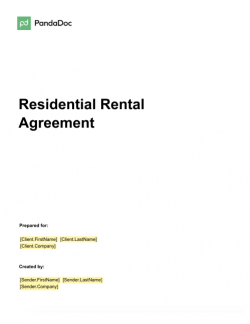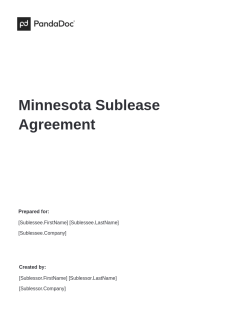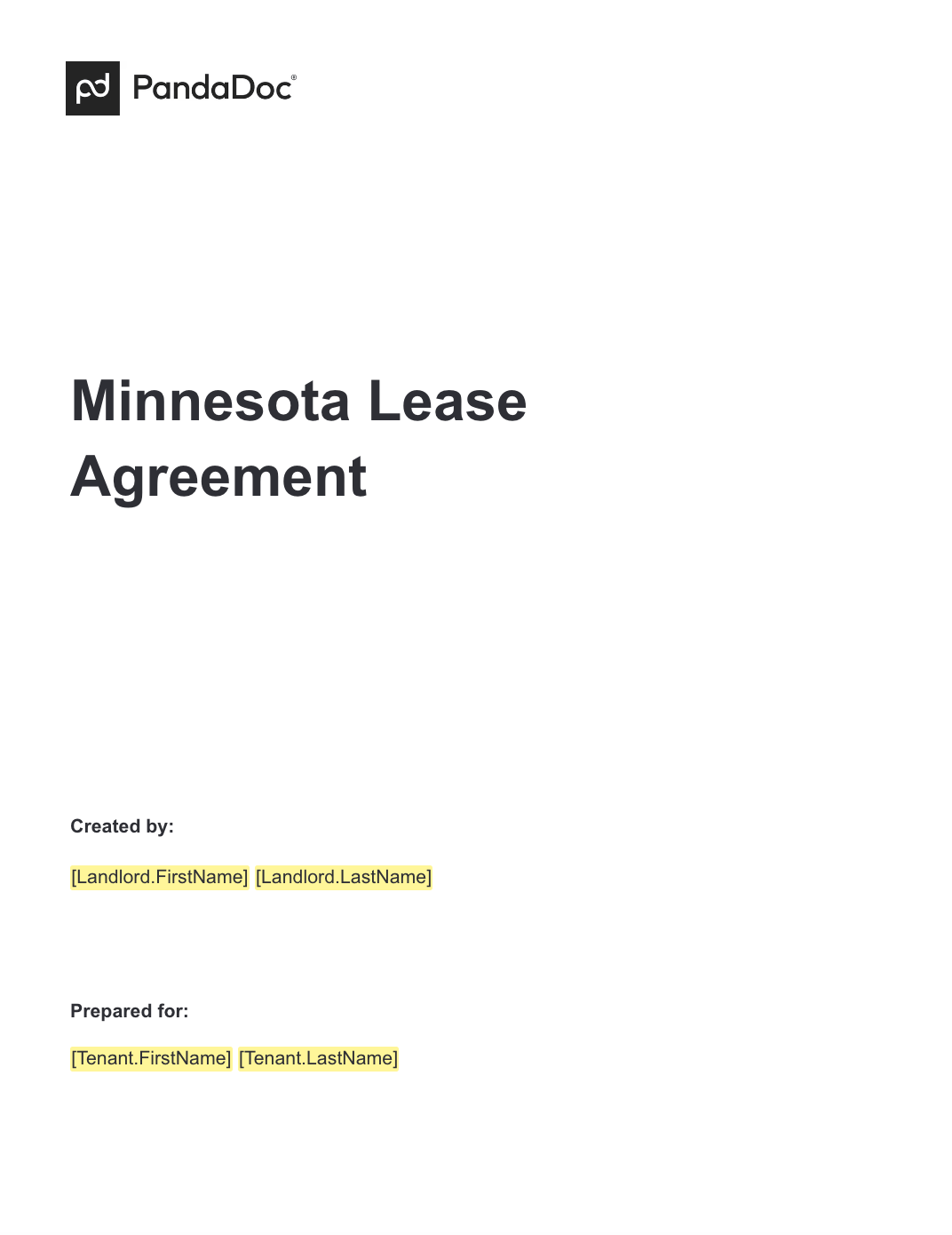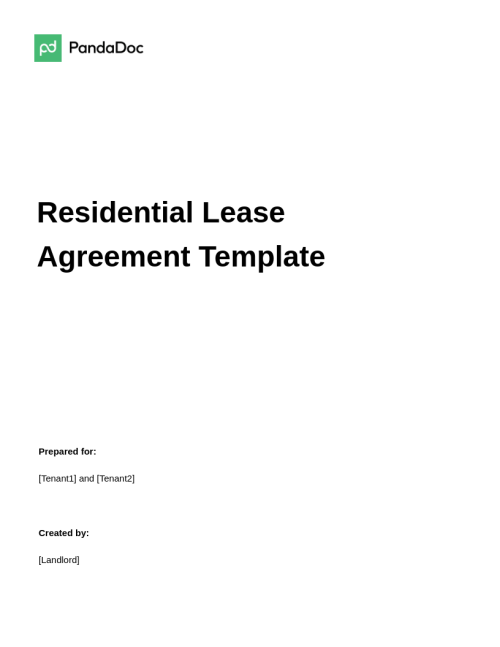Key Takeaways
- Chapter 504B – Landlord and Tenant laws of the 2023 Minnesota Statutes govern the laws surrounding leases.
- There’s no limit on the security deposit, but lessors must return it within three (3) weeks of terminating the lease.
- Eviction notices can range from immediate to three months, depending on the violation.
- Lessors must make a reasonable effort to notify the lessee of entering the property, and only for specific reasons.
- There are seven (7) mandatory disclosures in Minnesota.
Minnesota Lease Agreement Templates
Residential Lease Agreement

Residential Rental Agreement
Used 5,261 times
Save time and resources by using this customizable residential rental agreement to create legally binding contracts with your tenants. It includes detailed sections about all aspects of a typical tenancy, including terms, responsibilities, rent, duration, insurance, maintenance, and more.
This agreement serves as a formal agreement between landlords and tenants renting residential properties in Minnesota.
Minnesota Apartment Lease
Specifically designed for apartment rentals in Minnesota, this lease agreement outlines the terms and conditions of leasing an apartment unit, including rent, utilities, and maintenance responsibilities.
Minnesota Room Rental
Tailored for renting out individual rooms within a property, this template helps landlords and tenants establish clear guidelines for shared living spaces.
Minnesota Month-to-Month Lease
Offering flexibility without a long-term commitment, this lease agreement template allows for short-term rental arrangements in Minnesota, providing both landlords and tenants with the freedom to adjust rental terms as needed in a professional and legally binding manner.
Commercial Lease Agreement
This template is crafted for leasing commercial properties in Minnesota, covering essential aspects such as lease terms, rent adjustments, and property use restrictions.
Lease to Purchase Agreement
Providing a structured framework for lease-to-own arrangements, this agreement template offers tenants in Minnesota the option to purchase the property in the future while ensuring landlords maintain a stable rental income stream.
Sublease Agreement

Minnesota Sublease Agreement
Used 4,872 times
Use our customizable Minnesota sublease agreement to create a complete lease agreement that allows you to easily sublet a leased property in Minnesota.
Facilitating subleasing arrangements, this agreement template ensures clarity and professionalism between the original tenant and the subtenant, protecting the interests of all parties involved and adhering to Minnesota state laws and regulations.
Understanding Minnesota Rental Laws
In the 2023 Minnesota Statutes, Chapter 504B on Landlord and Tenant laws describes the terms and laws leases must comply with. We look at some of the main points in these laws you should pay attention to.
| Laws | Name | Description |
| Sections 504B.101 to 504B.151 | Leasing and Rent | All of the general terms regarding leasing a property. |
| Section 504B.125 | Person in Possession Liable for Rent; Evidence | A law that states how being in possession of the premises during a lease means you’re liable for rent. |
| Sections 504B.205 to 504B.211 | Tenant Rights | A section that describes the various tenant rights and protections. |
| Section 504B.161 | Covenants of Landlord or Licensor | Explanation of landlord obligations, such as keeping the unit in habitable conditions. |
| Section 504B.178 | Interest on Security Deposits; Withholding Security Deposits, Damages, Limit on Withholding Last Month’s Rent | All of the security deposit laws and terms. |
| Section 504B.135 | Terminating Tenancy at Will | The termination notice period, procedures, and reasons. |
| Sections 504B.281 to 504B.371 | Eviction Actions | All of the different reasons for evictions and the process of evicting a tenant. |
| Section 504B.211 | Residential Tenant’s Right to Privacy | A section describing the landlord’s right of entry and a tenant’s right to quiet enjoyment. |
| Section 504B.147 | Time Period for Notice to Quit or Rent Increase | See how long the notice period is for rent increases and the tenant’s right to quit. |
| Section 504B.151 | Restriction on Residential Lease Terms for Building in Financial Distress; Required Notice of Pending Foreclosure | Restrictions on some lease types due to the building’s financial status. |
Security Deposit Limits
- Minnesota has no limit on how much lessors can ask for when requiring a security deposit. However, generally, it’s good practice to keep the amount within one (1) to two (2) month’s rent.
- Lessors only need to provide written security deposit receipts if they receive them in cash.
- All security deposits must incur a non-compounded 1% annual interest. The lessor must pay this interest to the lessee annually. However, there’s no statutory provision that states the security deposit must be kept in a separate account.
- The return period of the security deposit is three (3) weeks after the lease ends. The lessor must provide a written statement of any deductions when returning the lease. Without this statement, the lessor might be held liable for the deducted amount and have to return it, with interest, to the lessee.
Eviction Procedures
- If the lessee violates the agreement terms, the lessor can immediately file for eviction.
- If the lessor files an unconditional quit notice for unpaid rent or other monetary obligations, then they must provide 14 days for the lessee to leave the premises.
- If the unconditional quit notice is for violations other than monetary obligations, then the notice period must be three (3) months or the rent interval, whichever is shorter.
Right to Enter (Landlord)
- There aren’t specific notice periods. However, lessors must make a good-faith effort to provide reasonable notice when entering the premises.
- Reasonable purpose to enter the property includes:
- Maintenance and repairs;
- Showing the unit to prospective buyers, lessees, and other agents;
- Completing inspections;
- If the lessee causes a disturbance.
- The only time the lessor doesn’t need to notify the lessee is when it’s an emergency to prevent injury to the lessees and the property. The only other reason is when unlawful activities occur on the premises.
Disclosures
Minnesota has quite a few mandatory disclosures. So, always ensure that you add all of them to the lease to prevent it from becoming invalid.
- Lessor’s Name and Address
- Disclosure of Any Late Fees
- Financial Distress Notice
- Shared Utilities Calculations
- Landlord/Tenant Covenant
- Lead-Based Paint Disclosure
- Disclosure of Outstanding Inspection Orders



